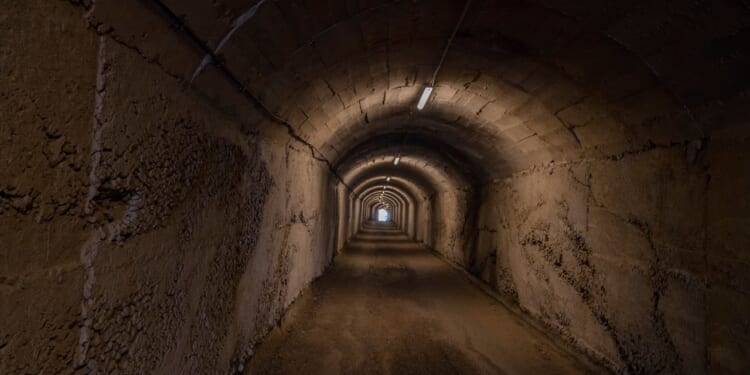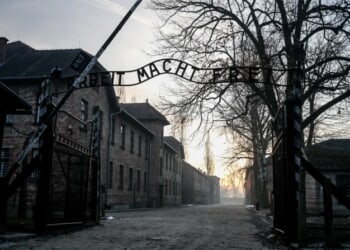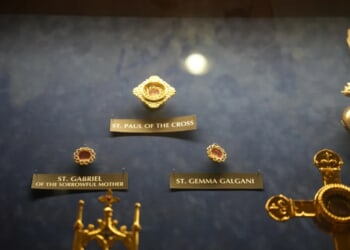America’s “Raven Rock” complex in southern Pennsylvania is perhaps the best-known of the US government’s hidden nuclear bunkers, but there are others as well.
Last month’s Netflix original film A House of Dynamite, directed by Academy Award winner Kathryn Bigelow, was met with some criticism from viewers, primarily due to its ambiguous ending. The Pentagon didn’t exactly care for the film, either—issuing a rare public comment criticizing the depiction of its interceptor missile program. Yet the film certainly sparked a debate about the threat of nuclear weapons, as it gave an inside look at how the United States government might respond to such an attack.
[Minor spoilers for “A House of Dynamite” below.]
One question asked by many viewers, besides whether or not Chicago—the target of the mystery missile central to the film’s plot—is destroyed in the nuclear attack, is whether the top secret Raven Rock Mountain Complex is real.
The short answer is yes. That facility has been described as an “underground Pentagon,” located in Adams County, Pennsylvania.
Raven Rock Mountain Complex is also known by a multitude of names, including Site R, Alternate Joint Communications Center (AJCC), Alternate National Military Command Center (ANMCC), National Military Command Center – Raven Rock (NMCC-4), the Rock, and “Harry’s Hole.” The latter name is associated with President Harry S. Truman, who authorized its construction in the early days of the Cold War. It was, and still is, meant to ensure government continuity in the event of a nuclear conflict.
What We Know About the Raven Rock Mountain Complex
While Raven Rock appears in the Fallout video game series—serving as a reminder that the complex’s existence is not a well-kept secret—it is probably not all like the “Vaults” featured in that game, recently adapted into an Amazon Video original series. It likely also isn’t anything like the “Silos” in the Apple original series Silo, based on the trilogy of novels by Hugh Howey.
Although it is known that the Raven Rock facility exists, the United States government has provided few details about what is actually under the mountain. It is one of the nation’s most closely guarded secret military facilities, roughly comparable to “Area 51” in southern Nevada.
Located within a mountain in southern Pennsylvania, on the border with northern Maryland, the site is reportedly equipped with an unparalleled level of security. It is self-sufficient, equipped with a power plant, water supply, and air filtration system. According to a 2017 report from NPR, a “free-standing city” exists within the hollowed-out mountain, comprising multiple three-story buildings.
“It has everything that a small city would — there’s a fire department there, there’s a police department, medical facilities, dining halls,” national security reporter Garrett Graff told NPR.
The NPR story cited Graff’s research from his book, Raven Rock: The Story of the US Government’s Secret Plan to Save Itself—While the Rest of Us Die. Graff also explained that, following the end of the Cold War and the dissolution of the Soviet Union, the need for Raven Rock became less apparent. On 9/11, however, area residents reported witnessing never-before-seen convoys of black SUVs, assumed to be carrying high-level government officials, through the area. The facility was restarted and expanded, and by 2017, it “could hold as many as 5,000 people in the event of an emergency.”
The purpose isn’t to ensure humanity survives a nuclear war or other global catastrophe, but to ensure a continuity of the US government. That means that most of those 5,000 inhabitants won’t be bringing family along with them. Even though it might be a self-contained underground city, the conditions are likely sparse and comparable to those of a relief shelter, featuring communal bathrooms, showers, and bunk beds instead of plush apartments.
Congress Had Its Own Secret Bunker—but It’s Not Secret Anymore
Raven Rock is just one of several government bunkers located throughout the United States that remain operational. The Cheyenne Mountain Complex in Colorado, run by the US Space Force, can fulfill a similar role for high-ranking military personnel during a crisis. The Mount Weather Emergency Operations Center, located in northern Virginia, is another such facility.
Perhaps the most accessible of America’s secret nuclear facilities is The Greenbrier, a former bunker located under the opulent resort nestled in the Allegheny Mountains near White Sulphur Springs, West Virginia.
The Greenbrier resort hosted “princes and politicians since its opening in 1778,” and then suddenly “broke ground on a new wing in late 1958,” Smithsonian magazine reported.
Such an expansion wasn’t out of the norm for a luxury hotel. However, the new project wasn’t for a new pool, meeting rooms, or even a sex dungeon for those who regularly roamed the corridors of power. Instead, it was for something more ominous. Locals noted that the expansion required massive amounts of concrete and huge steel doors.
Perhaps not surprisingly, given that it was an era before social media and the current distrust of the government, suspicions remained private and isolated within the community. Yet it was something very much worthy of a wild conspiracy theory. Underneath the Greenbrier, a new wing of the hotel was built as a secret nuclear bunker to provide “living and working space” for “every single member of the United States Congress” in the event of a nuclear war.
Given the name “Project Greek Island,” the Greenbrier expansion was completed just in time for the Cuban Missile Crisis, but was never occupied by lawmakers. It remained one of the government’s best-kept secrets from 1961 until 1992, even as the Watergate and Iran-Contra scandals became front page news.
Rumors persisted for years, but they were always dismissed. It has been reported that the locals took pride in knowing something was there, but didn’t talk about it.
The Greenbrier’s secret was finally spilled in 1992, when The Washington Post reported on its existence. The site was declassified the same year, and it has been open for tours since 1995.
Today, we know the bunker had 1,000 bunk beds and a 400-seat cafeteria, as well as two auditoriums for lawmakers, one for the House of Representatives and the other for the Senate. There was “a trash incinerator that could serve as a crematorium.” That suggested that lawmakers could have survived for weeks or months underground.
It is now well known that several “doomsday facilities” exist around the country, but for those who are chosen to survive—and generally must leave their families behind, to an uncertain fate—it could hardly be called living. It certainly would not have been in luxury.
About the Author: Peter Suciu
Peter Suciu has contributed over 3,200 published pieces to more than four dozen magazines and websites over a 30-year career in journalism. He regularly writes about military hardware, firearms history, cybersecurity, politics, and international affairs. Peter is also a contributing writer for Forbes and Clearance Jobs. He is based in Michigan. You can follow him on Twitter: @PeterSuciu. You can email the author: [email protected].
Image: Shutterstock / posztos.

















